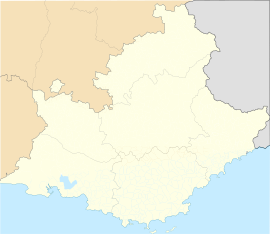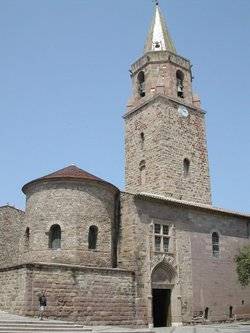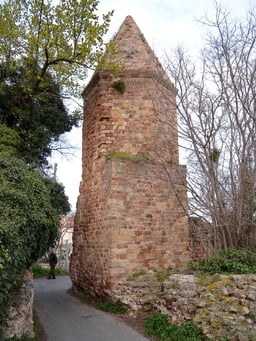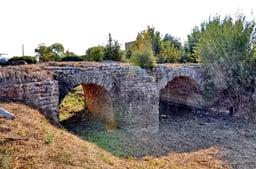Fréjus
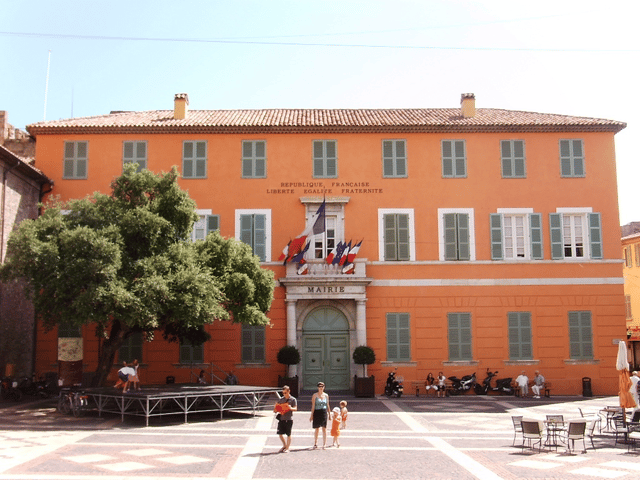
Fréjus

Fréjus | |
|---|---|
Location of Fréjus | |
| Coordinates:43°25′59″N 6°44′13″E [26] | |
| Country | France |
| Region | Provence-Alpes-Côte d'Azur |
| Department | Var |
| Arrondissement | Draguignan |
| Canton | Fréjus and Saint-Raphaël |
| Intercommunality | Var Estérel Méditerranée |
| Government | |
| • Mayor(2014–2020) | David Rachline (RN) |
| Area 1 | 102.27 km2(39.49 sq mi) |
| Population (2016-01-01)[1] | 54,023 |
| • Density | 530/km2(1,400/sq mi) |
| Time zone | UTC+01:00 (CET) |
| • Summer (DST) | UTC+02:00 (CEST) |
| INSEE/Postal code | 83061 [27] /83600 |
| Elevation | 0–616 m (0–2,021 ft) (avg. 8 m or 26 ft) |
| 1French Land Register data, which excludes lakes, ponds, glaciers > 1 km2(0.386 sq mi or 247 acres) and river estuaries. | |
Fréjus (Occitan: Frejús, French pronunciation: [fʁe.ʒys]) is a commune in the Var department in the Provence-Alpes-Côte d'Azur region in southeastern France.
It neighbours Saint-Raphaël, effectively forming one town. The north of the commune forms part of the Estérel Massif.
On 2 December 1959, the Malpasset Dam, on the Reyran River above Fréjus, ruptured, killing over 400 people.
Fréjus | |
|---|---|
Location of Fréjus | |
| Coordinates:43°25′59″N 6°44′13″E [26] | |
| Country | France |
| Region | Provence-Alpes-Côte d'Azur |
| Department | Var |
| Arrondissement | Draguignan |
| Canton | Fréjus and Saint-Raphaël |
| Intercommunality | Var Estérel Méditerranée |
| Government | |
| • Mayor(2014–2020) | David Rachline (RN) |
| Area 1 | 102.27 km2(39.49 sq mi) |
| Population (2016-01-01)[1] | 54,023 |
| • Density | 530/km2(1,400/sq mi) |
| Time zone | UTC+01:00 (CET) |
| • Summer (DST) | UTC+02:00 (CEST) |
| INSEE/Postal code | 83061 [27] /83600 |
| Elevation | 0–616 m (0–2,021 ft) (avg. 8 m or 26 ft) |
| 1French Land Register data, which excludes lakes, ponds, glaciers > 1 km2(0.386 sq mi or 247 acres) and river estuaries. | |
History
The origins of Frejus probably lie with the Celto-Ligurian people who settled around the natural harbour of Aegytna. The remains of a defensive wall are still visible on Mont Auriasque and Cap Capelin. The Phocaeans of Marseille later established an outpost on the site.
Foundation
Frejus was strategically situated at an important crossroads formed by the Via Julia Augusta (which ran between Italy and the Rhône) and the via Domitiana. Although there are only few traces of a settlement at that time, it is known that the famous poet Cornelius Gallus was born there in 67 BC.[2]
Julius Caesar wanted to supplant Massalia and he founded the city as 'Forum Julii' meaning 'market of Julius'; he also named its port 'Claustra Maris' (the sea barrier).
The exact date of the founding of Forum Julii is uncertain, but it was certainly before 43 BC since it appears in the correspondence between Plancus and Cicero and 49 BC is most likely.
Roman city
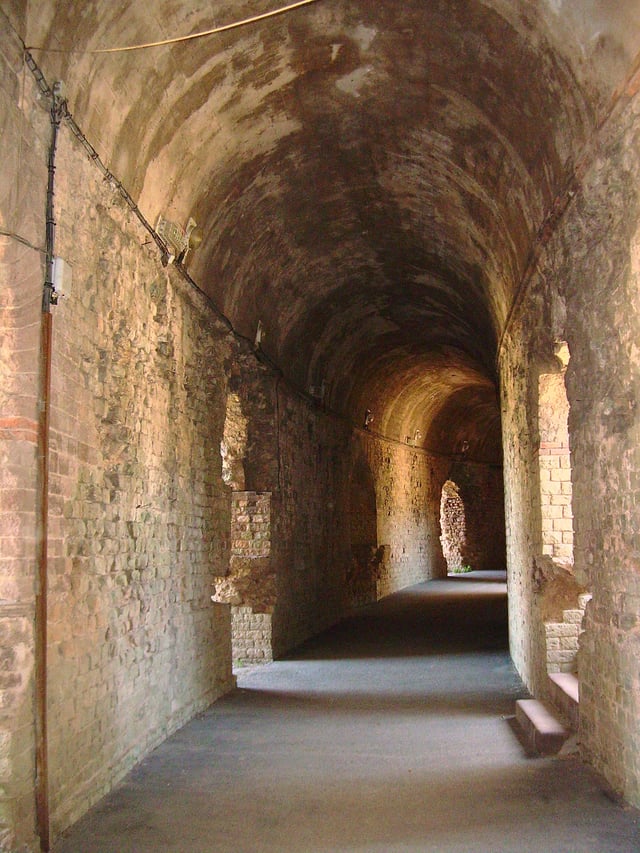
Amphitheatre
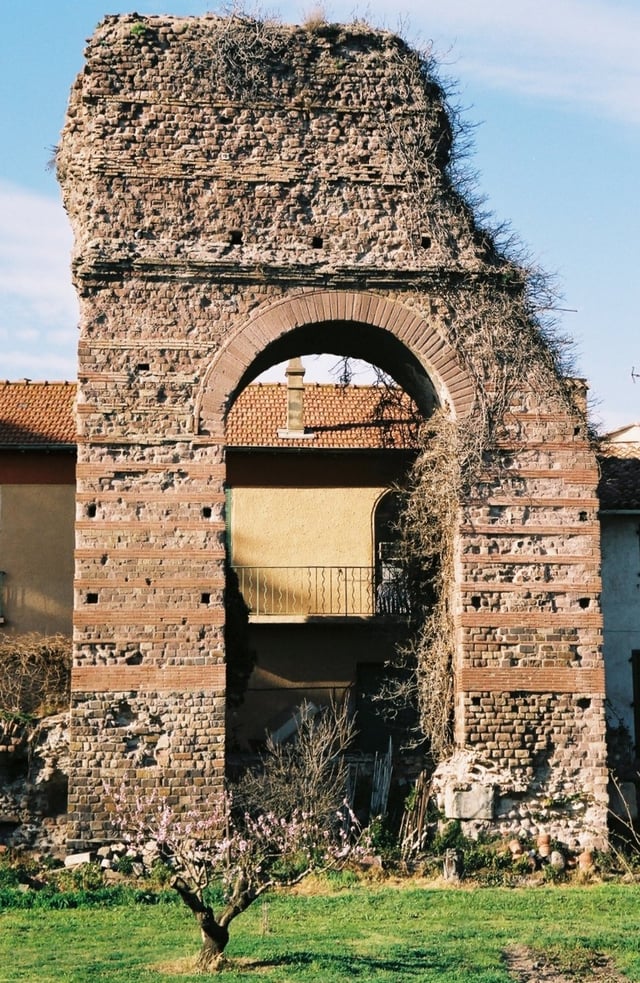
Roman baths: fridarium arch (Porte Dorée)
Augustus made the city the capital of the new province of Narbonensis in 22 BCE, spurring rapid development. It became one of the most important ports in the Mediterranean; its port was the only naval base for the Roman fleet of Gaul and only the second port after Ostia until at least the time of Nero.[5]
Subsequently, under Tiberius, the major monuments and amenities still visible today were constructed: the amphitheatre, the aqueduct, the lighthouse, the baths and the theatre. Forum Julii had impressive walls of 3.7 km length that protected an area of 35 hectares. There were about six thousand inhabitants. The territory of the city, the civitas forojuliensis, extended from Cabasse in the west to Fayence and Mons in the north.
It became an important market town for craft and agricultural production. Agriculture developed with villa rusticas such as at Villepey[6] and St. Raphael. Mining of green sandstone and blue porphyry and fish farming contributed to the thriving economy.
In 40 CE Gnaeus Julius Agricola, who later completed the Roman conquest of Britain, was born in Forum Julii. He was father-in-law of the historian Tacitus, whose biography of Agricola mentions that Forum Julii was an "ancient and illustrious colony".[7] The city was also mentioned several times in the writings of Strabo and Pliny the Elder.
In early 69 the Battle of Forum Julii was fought between the armies of the rival emperors Otho and Vitellius.[8] The exact location of this battle is not known, but afterwards Vitellius retreated to Antipolis.
The 4th century saw the creation of the diocese of Fréjus, France's second largest after that of Lyon; the building of the first church is attested in 374 with the election of a bishop. Saint-Léonce became Bishop of Fréjus in 433 and wrote: "From 374, at the Council of Valencia, a bishop was appointed in Frejus, but he never came. I was the first of the bishops of that city. I was able to build the first Cathedral with its Baptistery."
The decay of Rome led to that of the cities of its empire.
Monuments
The richest architecture belongs to the Roman city whose many buildings make it the richest concentration of this period in France after Arles. The most notable are:
The amphitheatre
The aqueduct
the theatre.
In addition the old town is home to many other impressive remains: the walls, the three gates (of Rome, of Reyran, and "Dorée"), the square of Agricola with the gate of the Gauls, an exedra and the platform with a cistern and baths on the Butte Saint-Antoine, the paving of the via Aurelia which passed through the city, the remains of the ancient harbour with the remains of the north quay, the lighthouse and quay of Augustus, a mosaic floor of fighting cocks in a private property, and the sewers under the present rue Jean Jaures.
Nearby there is also a 4th-century mausoleum at rue de La Tourrache in the Villeneuve suburb, the remains of a suburban villa at La Rose des Sables, Roman road bridges at Cantonniers and at Esclapes (with three arches), a fulling mill at Arsenal, remains in Villepey, a necropolis in Sainte-Brigitte and fishponds on the coast at Saint-Aygulf.
Aqueduct
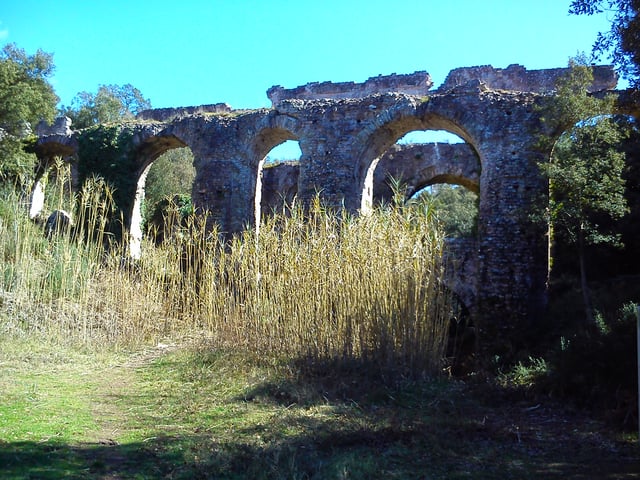
Aqueduct bridge at Senequier
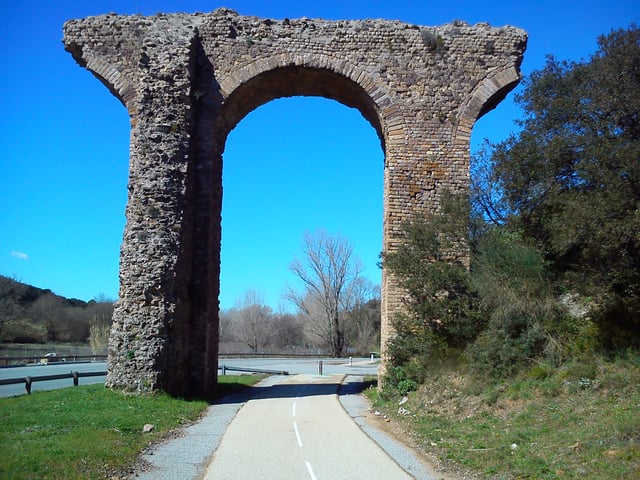
Aqueduct bridge over the Gargalon stream
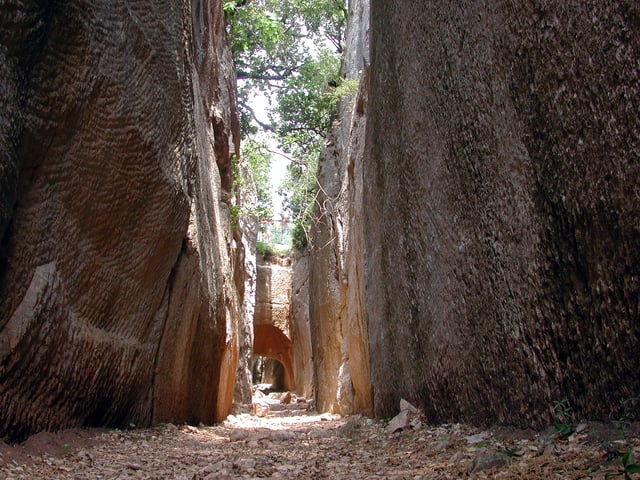
Near the source of the aqueduct at "Roche Taillee"
The aqueduct is 42 km long and runs for 1.8 km on bridges and 500m on walls. Large parts of the aqueduct are still well preserved.[11]
Roman port
An archaeological campaign in July 2005[12] revealed a portion of ancient rocky coast which showed it was almost one kilometre further inland than current estimates. In the middle of the 1st century A.D. at the time of the creation of Forum Iulii, this coastline was a narrow band of approximately 100m wide at the south of the Butte Saint-Antoine. Further recent archaeology has revealed much information on the ancient port.[13] A Triton monument was discovered at the entrance to the harbour. This statue and the remains of a Roman building at the end of the eastern quay nearby, shows this site to be a lighthouse. Two lighthouses were constructed on the quays and a third assisted mariners in locating the harbour’s sea entrance. The third, situated on the Île du Lion de Mer, would have been the primary beacon that ships would have navigated toward. As ships approached the harbour, the Triton lighthouse on the northern side of the channel into the harbour and the other lighthouse on the southern side would have marked the entrance and thus provided safe passage into the harbour.
Post-Roman history

Cathédrale Saint-Léonce of Fréjus with its Merovingian baptistery
Between the 7th and the 9th centuries, Muslim invaders repeatedly raided the city. The sea encroached on the land while invasions by the Muslims and pirates left the monuments in ruin. By the 10th century there was very little left of the colony, mostly rubble. Sea-borne silt clogged up the port and led to the formation of a huge swampy plain, which then separated the village from the sea.
Napoleon Bonaparte landed at Frejus on 9 October 1799, returning from Egypt in order to ostensibly defend the French Directory in Paris.
During the First World War Fréjus became the main centre for hivernage (wintering) for the Senegalese Tirailleurs. The town also contained segregated hospitals with images of African village life painted on the walls.[14]
List of mayors
| Start | End | Name | Party | |
|---|---|---|---|---|
| 1977 | 1997 | François Léotard | UDF–PR | |
| 1997 | 2014 | Élie Brun | UMP | |
| 2014 | David Rachline | FN | ||
Notable people
Gnaeus Julius Agricola, Roman governor of the province of Britain
St. Maximus, Abbot at Lerins and Bishop of Frejus (d. 460)
Kévin Constant, footballer
Mario Espartero, footballer
Odiah Sidibe, athlete
Abbé Sieyès, French Revolution theorist and author of What is the Third Estate?, was born in Fréjus in 1748
Mickael Abbate, director and producer, was born in Fréjus in 1983
Marc Andreu, rugby union player
Anthony Modeste, footballer
Adil Rami, footballer
Layvin Kurzawa, footballer
Other sights
Fréjus organises several fairs throughout the year, and there is the pottery fair and the Bravade amongst its Roman and Gothic architecture with the 'old tile' roof tops and tinted walls. Everything blends in with the recently developed port and its neo-palladian design and carefully selected Provençal colours. Port Fréjus which has a capacity of 750 moorings, is surrounded by beautiful fine sandy beaches. As a backdrop there is the massif de l'Esterel, the (Esterel hills) and its 'Nature' base situated on the sea edge, as well as protecting the area and its environment. Many sporting events are held here. There's the annual 'Roc d'Azur' mountain bike event.
Transport
The Gare de Fréjus railway station offers connections to Toulon, Nice and several regional destinations. Long distance destinations are accessible from the nearby Gare de Saint-Raphaël-Valescure. The A8 motorway connects Fréjus with Aix-en-Provence and Nice.
Climate
Fréjus has a hot-summer mediterranean climate (Köppen climate classification: Csa)
| Climate data for Fréjus (1981–2010 averages, extremes 1919–present) | |||||||||||||
|---|---|---|---|---|---|---|---|---|---|---|---|---|---|
| Month | Jan | Feb | Mar | Apr | May | Jun | Jul | Aug | Sep | Oct | Nov | Dec | Year |
| Record high °C (°F) | 22.8 (73.0) | 23.0 (73.4) | 27.3 (81.1) | 28.3 (82.9) | 32.6 (90.7) | 37.7 (99.9) | 42.5 (108.5) | 41.5 (106.7) | 35.0 (95.0) | 35.9 (96.6) | 26.6 (79.9) | 23.2 (73.8) | 42.5 (108.5) |
| Average high °C (°F) | 13.1 (55.6) | 13.8 (56.8) | 16.1 (61.0) | 18.0 (64.4) | 22.0 (71.6) | 25.7 (78.3) | 28.8 (83.8) | 28.9 (84.0) | 25.5 (77.9) | 21.3 (70.3) | 16.7 (62.1) | 13.5 (56.3) | 20.3 (68.5) |
| Daily mean °C (°F) | 8.2 (46.8) | 8.6 (47.5) | 10.8 (51.4) | 13.0 (55.4) | 17.0 (62.6) | 20.6 (69.1) | 23.3 (73.9) | 23.4 (74.1) | 20.2 (68.4) | 16.6 (61.9) | 12.0 (53.6) | 8.9 (48.0) | 15.3 (59.5) |
| Average low °C (°F) | 3.3 (37.9) | 3.4 (38.1) | 5.6 (42.1) | 8.0 (46.4) | 11.9 (53.4) | 15.4 (59.7) | 17.9 (64.2) | 18.0 (64.4) | 14.8 (58.6) | 11.8 (53.2) | 7.3 (45.1) | 4.3 (39.7) | 10.2 (50.4) |
| Record low °C (°F) | −9.0 (15.8) | −12.0 (10.4) | −8.6 (16.5) | −1.8 (28.8) | 1.1 (34.0) | 5.5 (41.9) | 7.5 (45.5) | 7.7 (45.9) | 4.5 (40.1) | 0.1 (32.2) | −3.3 (26.1) | −7.0 (19.4) | −12.0 (10.4) |
| Average precipitation mm (inches) | 70.6 (2.78) | 41.6 (1.64) | 45.0 (1.77) | 73.9 (2.91) | 45.7 (1.80) | 33.2 (1.31) | 13.1 (0.52) | 35.8 (1.41) | 74.7 (2.94) | 119.5 (4.70) | 99.7 (3.93) | 94.5 (3.72) | 747.3 (29.42) |
| Average precipitation days(≥ 1.0 mm) | 5.9 | 4.8 | 4.9 | 7.2 | 5.0 | 3.6 | 1.4 | 2.4 | 4.8 | 7.4 | 7.3 | 6.5 | 61.2 |
| Average snowy days | 0.7 | 0.4 | 0.1 | 0.0 | 0.0 | 0.0 | 0.0 | 0.0 | 0.0 | 0.0 | 0.1 | 0.2 | 1.5 |
| Average relative humidity (%) | 75 | 73 | 72 | 73 | 76 | 75 | 73 | 74 | 77 | 78 | 77 | 76 | 74.9 |
| Mean monthly sunshine hours | 155.9 | 166.6 | 217.7 | 220.7 | 264.9 | 311.1 | 346.1 | 313.4 | 234.2 | 171.9 | 141.6 | 121.2 | 2,665.2 |
| Source #1: Meteo France[15] | |||||||||||||
| Source #2: Infoclimat.fr (humidity and snowy days 1961–1990)[16] | |||||||||||||
Twin towns - sister cities
Fréjus is twinned with:
[[INLINE_IMAGE|//upload.wikimedia.org/wikipedia/en/thumb/a/a4/Flag_of_the_United_States.svg/23px-Flag_of_the_United_States.svg.png|//upload.wikimedia.org/wikipedia/en/thumb/a/a4/Flag_of_the_United_States.svg/35px-Flag_of_the_United_States.svg.png 1.5x, //upload.wikimedia.org/wikipedia/en/thumb/a/a4/Flag_of_the_United_States.svg/46px-Flag_of_the_United_States.svg.png 2x|United States|h12|w23|thumbborder flagicon-img flagicon-img]] Fredericksburg, Virginia, USA
[[INLINE_IMAGE|//upload.wikimedia.org/wikipedia/en/thumb/b/ba/Flag_of_Germany.svg/23px-Flag_of_Germany.svg.png|//upload.wikimedia.org/wikipedia/en/thumb/b/ba/Flag_of_Germany.svg/35px-Flag_of_Germany.svg.png 1.5x, //upload.wikimedia.org/wikipedia/en/thumb/b/ba/Flag_of_Germany.svg/46px-Flag_of_Germany.svg.png 2x|Germany|h14|w23|thumbborder flagicon-img flagicon-img]] Triberg, Germany
[[INLINE_IMAGE|//upload.wikimedia.org/wikipedia/en/thumb/c/c3/Flag_of_France.svg/23px-Flag_of_France.svg.png|//upload.wikimedia.org/wikipedia/en/thumb/c/c3/Flag_of_France.svg/35px-Flag_of_France.svg.png 1.5x, //upload.wikimedia.org/wikipedia/en/thumb/c/c3/Flag_of_France.svg/45px-Flag_of_France.svg.png 2x|France|h15|w23|thumbborder flagicon-img flagicon-img]] Dumbéa, France
[[INLINE_IMAGE|//upload.wikimedia.org/wikipedia/en/thumb/0/03/Flag_of_Italy.svg/23px-Flag_of_Italy.svg.png|//upload.wikimedia.org/wikipedia/en/thumb/0/03/Flag_of_Italy.svg/35px-Flag_of_Italy.svg.png 1.5x, //upload.wikimedia.org/wikipedia/en/thumb/0/03/Flag_of_Italy.svg/45px-Flag_of_Italy.svg.png 2x|Italy|h15|w23|thumbborder flagicon-img flagicon-img]] Paola, Italy
[[INLINE_IMAGE|//upload.wikimedia.org/wikipedia/commons/thumb/c/ce/Flag_of_Tunisia.svg/23px-Flag_of_Tunisia.svg.png|//upload.wikimedia.org/wikipedia/commons/thumb/c/ce/Flag_of_Tunisia.svg/35px-Flag_of_Tunisia.svg.png 1.5x, //upload.wikimedia.org/wikipedia/commons/thumb/c/ce/Flag_of_Tunisia.svg/45px-Flag_of_Tunisia.svg.png 2x|Tunisia|h15|w23|thumbborder flagicon-img flagicon-img]] Tabarka, Tunisia
See also
Bishopric of Fréjus
Malpasset
Communes of the Var department




